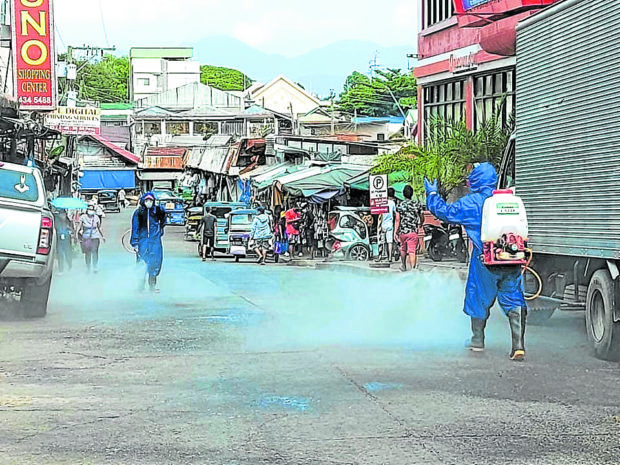
OPLAN LINIS Puerto Princesa City workers conduct regular decontamination in public places under its Oplan Linis program, using a spray made of bleach diluted in water. —CITY INFORMATION OFFICE PHOTO
PUERTO PRINCESA CITY, Palawan, Philippines — Local officials here announced plans to boost its testing capacity and vaccine rollout following an alarming rise in coronavirus cases in the city that a health expert group said registered a positivity rate higher than Metro Manila.
Authorities said the ramped up testing and vaccination would come hand in hand with ongoing strict implementation of health and safety protocols.
The moves came after OCTA Research Group fellow Dr. Guido David said in a radio interview on Monday that Puerto Princesa’s positivity rate of 77 percent, which was significantly higher that Metro Manila’s 12 percent, could have been the result of the lack of testing in the city, with almost eight of every 10 persons tested coming out positive for COVID-19.
On Monday, the City Epidemiology and Surveillance Unit (Cesu) released a bulletin stating that 111 of the 120 persons recently tested were positive for the virus, bringing to 423 the active cases in the city.
The number was a huge jump from the three active cases on March 3, Cesu data showed. The active infections also accounted for nearly a third of the 1,478 cases reported in the city since the pandemic struck in March last year.
City health officials have not determined the cause of the spike in cases but they have attributed it to the opening of Puerto Princesa’s borders when Metro Manila was downgraded to general community quarantine (GCQ) last March and leisure travelers from the national capital entered the city and the rest of Palawan province.
Interventions
The city, which is under GCQ, the most relaxed quarantine classification, until May 31, was also forced to halt its community testing after it ran out of supply at the end of the first quarter this year. The city received fresh supply from the Department of Health (DOH) on April 9, with 1,440 testing cartridges.
Lawyer Norman Yap, spokesperson of the city COVID-19 task force, said they were not surprised by OCTA’s findings since the city has been identified as an “area of concern” since March 29.
“We have been addressing and will continue to address this concern. Aside from the localized ECQ (enhanced community quarantine) and hard lockdown last month, [we still impose] the liquor ban and curfew, and the extended travel ban [for leisure travelers],” Yap said.
Yap added that the city also rolled out interventions by way of executive orders issued by Mayor Lucilo Bayron, including imposing workplace regulations and the setting up of the COVID-19 sheriff program that reinforced the strict implementation of health protocols.
“We are also setting up additional quarantine facilities. Our citywide quarantine classification has also been escalated … All the same, we appeal to all residents to stay at home and to go out only when it is absolutely necessary,” Yap added.
Boost testing
City Health Office chief Dr. Ric Panganiban, speaking before the city council on Monday, said they hoped to boost their testing capability when a molecular laboratory in Barangay Sta. Monica opens by June.
Private doctors and government health-care workers also joined forces to hasten the vaccination rollout before the vaccines expire in June, Panganiban said.
On May 15, Bayron met with doctors from Palawan Medical Society to ask for their help in the vaccination of city residents.
So far, 6,633 individuals received their first dose of the vaccine, while 1,921 completed their second dose as of Friday.
The city has received 15,330 vaccines—9,130 CoronaVac from China’s Sinovac Biotech Ltd. and 6,200 from British-Swedish company Oxford-AstraZeneca. It is expected to get the 200,000 jabs it ordered from AstraZeneca by July, added Panganiban.
The city aims to inoculate at least 180,000 individuals to achieve herd immunity from at least 70 percent of its residents.